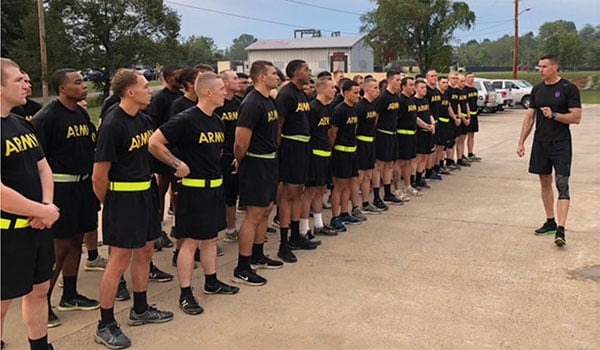
ARSOAC Commander Update / By BG Allan M. Pepin: Since October 2001, the Army Special Operations Aviation (ARSOA) enterprise has continuously deployed globally in support of SOF ground forces. Executing dynamic missions in challenging environments without fail is the result of our brave men and women.

BG Pepin addresses Soldiers during a physical training session while visiting Fort Campbell, KY. / ARSOAC PHOTO
They often push themselves and their equipment to the upper limits of human ability and equipment capability. Amazingly and consistently, they do this +/- 30 seconds time on target. This unique ability is a result of a continued adaption and innovation since the early 1980s.
Today, the United States Army Special Operations Aviation Command (ARSOAC) continues to meet the current challenges, while pursuing modernization efforts to prepare for the next fight in Joint Multi-Domain Operations (JMDO). As the 160th Special Operations Aviation Regiment’s and other unit’s higher headquarters, ARSOAC has Title X responsibilities of manning, training, equipping and modernizing the operational units. While our people remain our most important resource, our modernization efforts focus on improving operator capabilities through evolutions in technology and capability. These advancements will increase readiness and lethality in the future peer adversarial environments, while enabling or removing humans, when and where able, with the evolution of artificial intelligence (AI).
Our sustainable readiness model (SRM) began well before 9/11 due to the demand exceeding the supply of ARSOA units. The impact of nearly 18 years of sustained combat operations has placed increased requirements and demands for our force to remain ready and lethal. At the individual level, ARSOAC is enhancing unit programs aligned with USSOCOM’s program focused on individual readiness and enhanced quality of life, called Preservation of the Force and Family (POTFF). The pillars of this program include: 1) Human Performance which includes physical performance, physical rehabilitation, working memory, and cognitive load management; 2) Psychological Performance, 3) Social Performance, and 4) Spiritual Performance. These are designed to enhance human readiness, resiliency and life longevity. Individual readiness is a key component to remaining ready to deploy anywhere in the world, on short notice, to enable ground forces to fight and win.
Training
To ensure our battalions remain ready to deploy as an ARSOA Task Force, ARSOAC established an external evaluations (EXEVAL) process to validate battalion commanders and staffs (2-levels down doctrinal process). To maximize the training opportunity, while minimizing increased perstempo, we overlap these EXEVALs in conjunction with battalion training exercises and regimental flight lead evaluations. These complex training exercises, which include a dedicated ground force to enable training objectives, as well external fixed and rotary wing support from Joint and other Components, support mission essential training list (METL) focused and training at echelon. We also generate ready forces through Joint and home station tough and realistic training. We can push crews past failure points through the innovative and integrated use of simulations and simulator training. Sustained readiness allows commanders at echelon to remain laser focused on adapting tactical, operational and strategic capabilities to preserve options for Department of Defense and Geographical Combatant Commanders in support of our National Defense Strategy.
Modernization
Our prioritized modernization efforts focus on providing enhanced combat power for the joint force in the demanding and diverse environmental conditions we will face. Maintaining a comparative advantage in shoot, move, communicate, survive, and sustain capabilities to meet current and future challenges requires an investment in modernization initiatives and continual refinement of tactics, techniques and procedures in Joint Force interoperability. We are actively pursuing the most practical and cost-effective equipment, while continuing to leverage technology to increase the survivability of our crews and ground force. This includes AI efforts to track and use data to support condition-based maintenance, which will decrease sustainment costs over time that will enable increased investments in other priorities. There are ongoing efforts to optimize our navigation, weapons, targeting, communications and mission command systems and architecture for interoperability and effectiveness in a cyber and electronic warfare (EW) contested environment. This is critical as JMDO will require the ability to operate within adversary domains using air, land, sea, space and cyber space domain systems adding to an already complex physical environment.
In partnership with Army Cross-Functional Team programs, ARSOAC seeks to invest in SOF-unique capabilities, and adapt to emerging technologies and training in order to maintain readiness. Our efforts must encompass lethality, maneuverability, mission command, countering advanced air defense systems, and optimizing our sustainment of combat power. We anticipate the introduction of a longer-range precision munition as an alternative to the Hellfire for the AH-6, MH-60M and Gray Eagle, to allow us to engage targets at greater ranges to increase lethality. We are investing to upgrade our MH-47Gs to close the gap between SOF and Army platforms by providing commonality of parts, reduction of support costs, and cost sharing between Services; the Mission Enhanced Little Bird (MELB) to increase speed, payload, and maneuverability and closely monitoring and supporting the developments of the Future Vertical Lift (FVL) and Future Tactical Unmanned Aerial Systems (FTUAS) programs.
Before a person or platform departs home station, the ecosystem of ARSOA and SOF Acquisition is committed to producing the best capability in people and equipment. Due to the changing global environment and technological advancements, we must keep an eye on the horizon to set the conditions for future missions in a more complex environment. The reality is we will not always have the ability to pick and choose the time and place of the next mission, and we will execute with the equipment we have, not always with what we wished we had. Therefore, as we modernize, we must continue the high level of training, leader development and adaption to new doctrine within our formations. Tough, realistic training that develops leaders and crews at echelon and our honest and professional candid AARs remains the bedrock of readiness.
It is an honor to be part of the great accomplishments of the Aviation community and its support to the ground forces we support. ARSOA cannot exist without the integration, collaboration and support of the rest of the Army Aviation community. We also realize we have the ability to enhance Army Aviation with an exchange of information on successful SOF expedited modernization efforts that enhance lethality and survivability. I remain humbled to serve with the men and women whose honorable and selfless service to our Nation, as well as the sacrifices of their families is inspirational. We are a team of teams and winning is the only acceptable outcome.
Volare Optimos! To fly the best!
BG Allan M. Pepin is the commander of U.S. Army Special Operations Aviation Command located at Fort Bragg, NC.
























